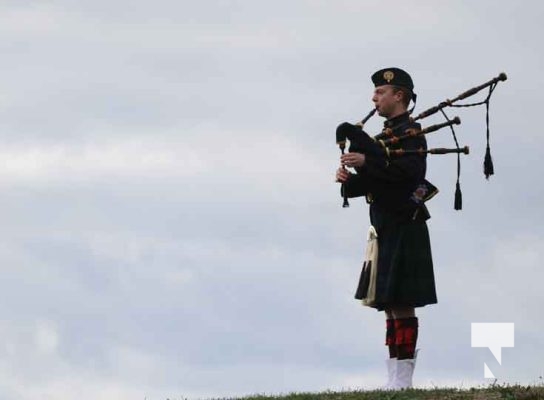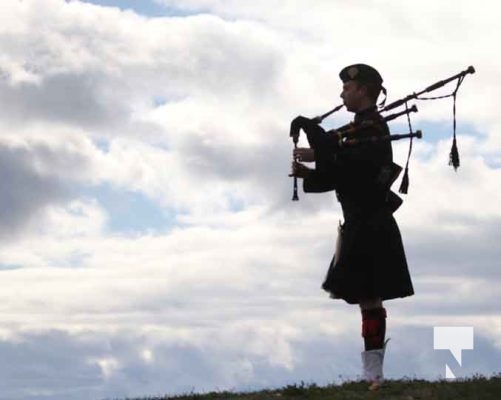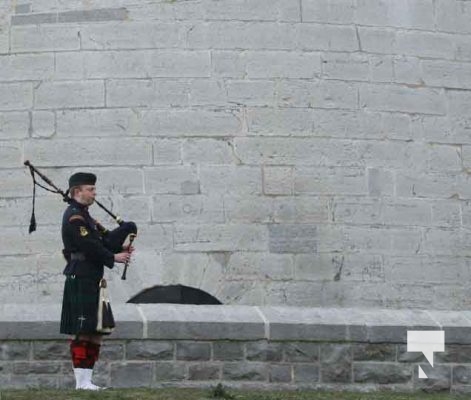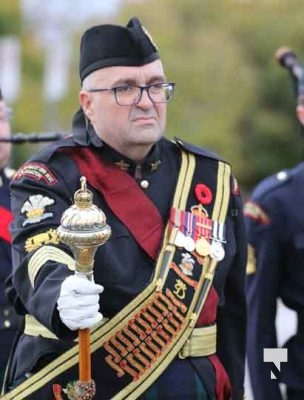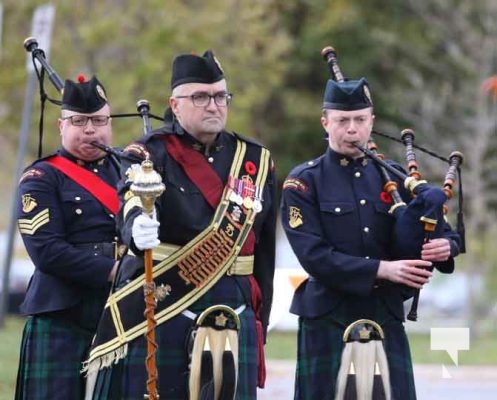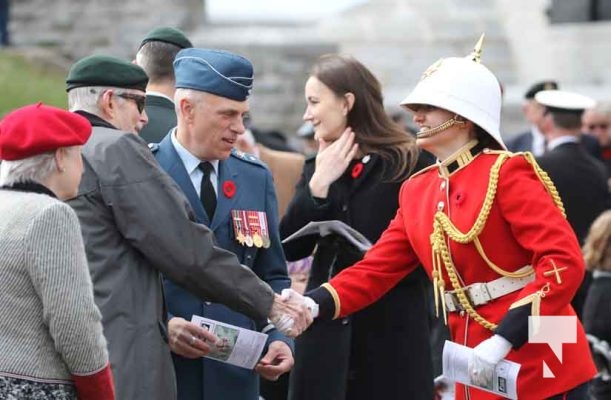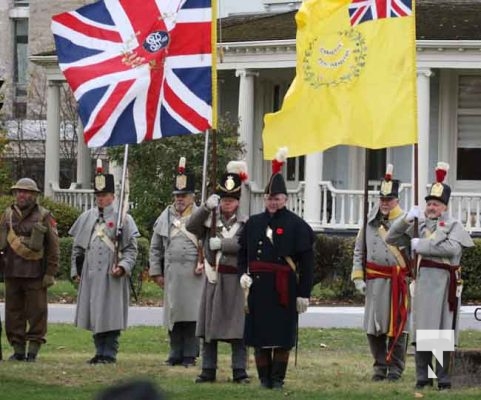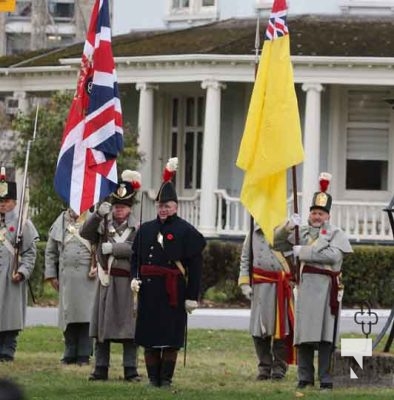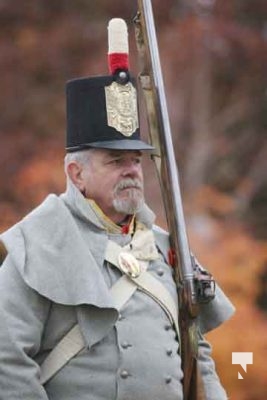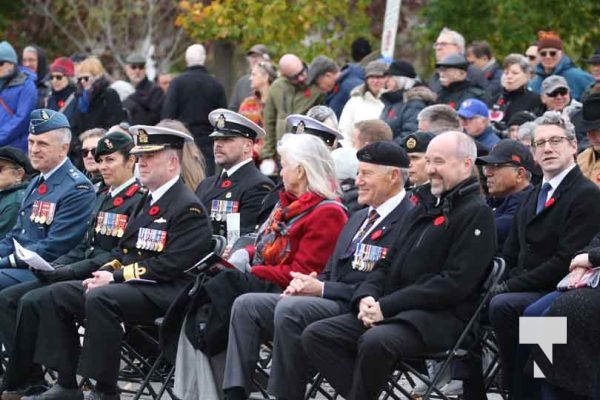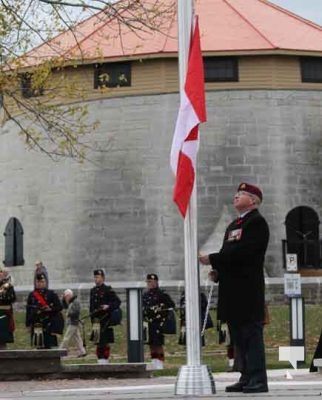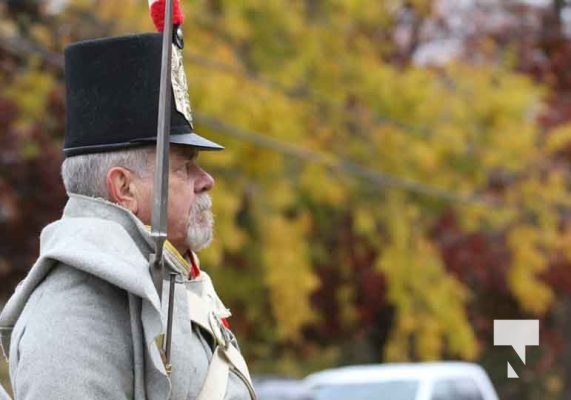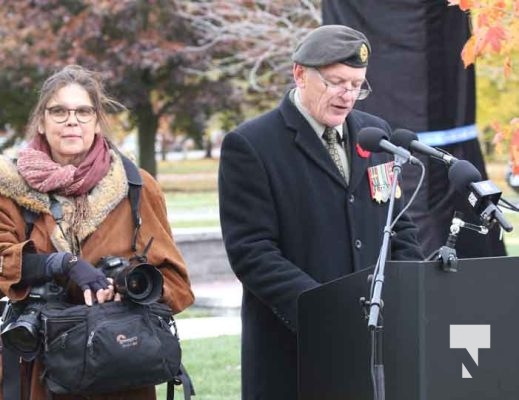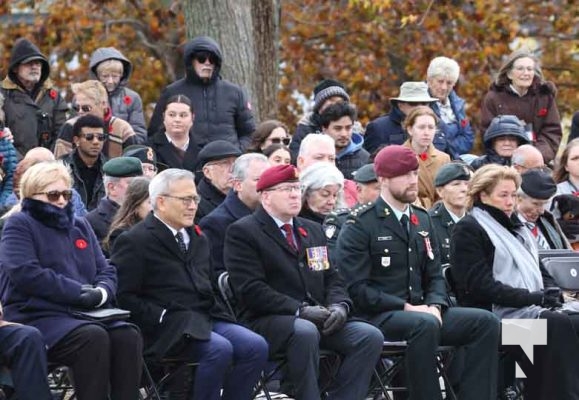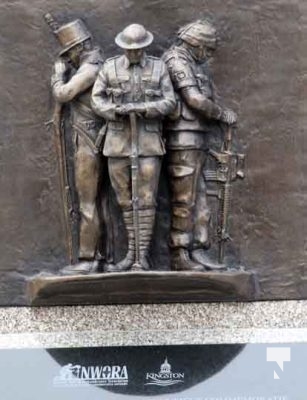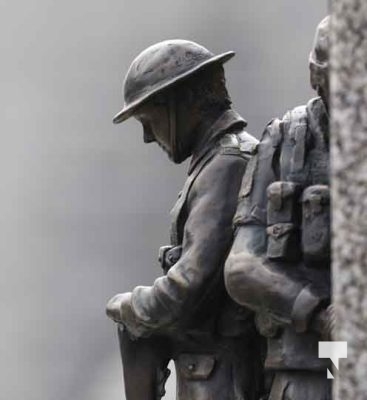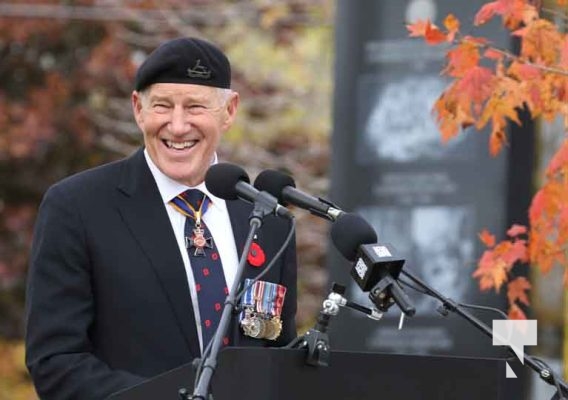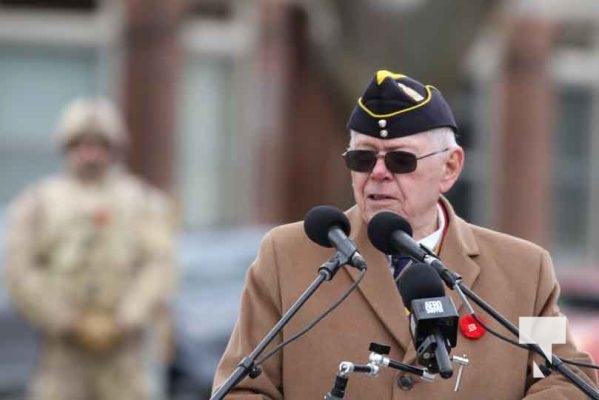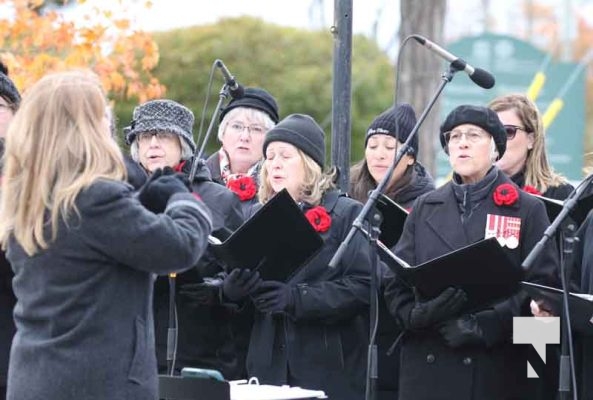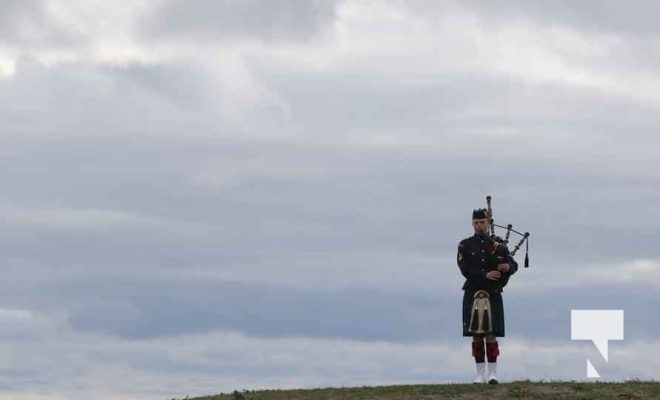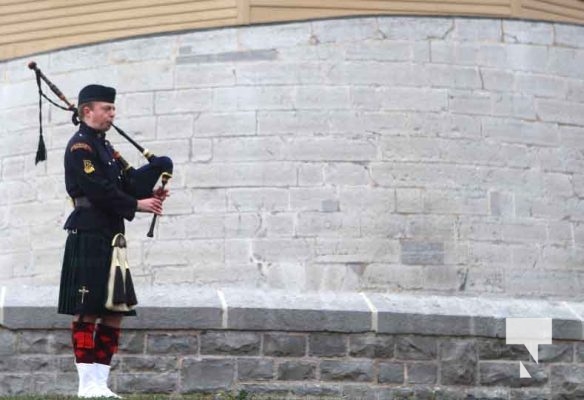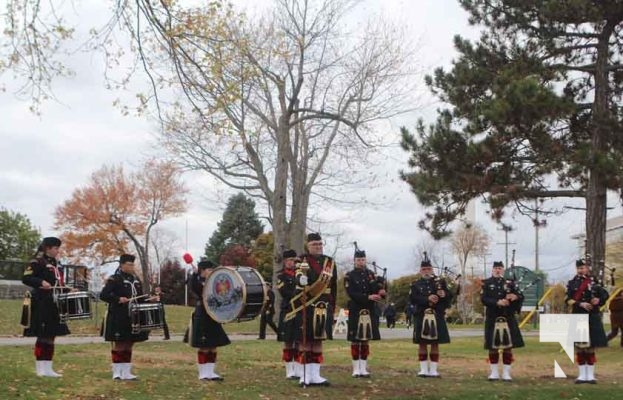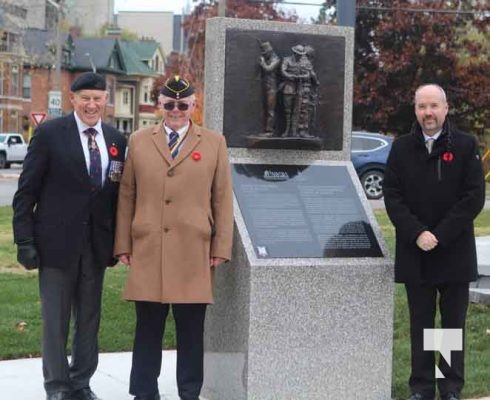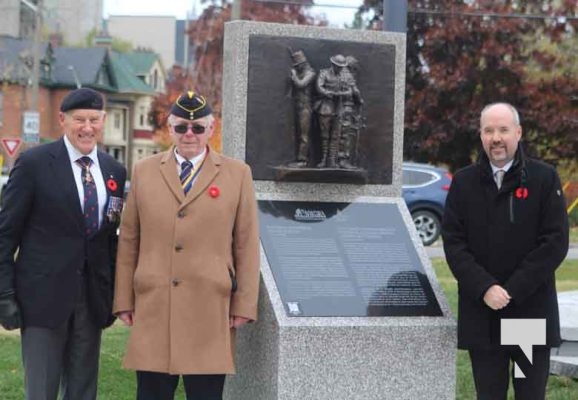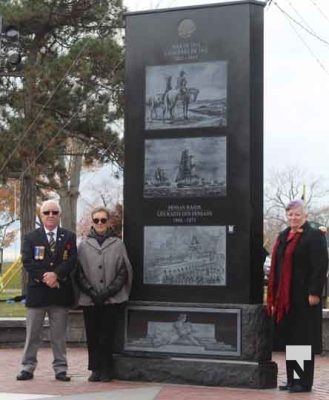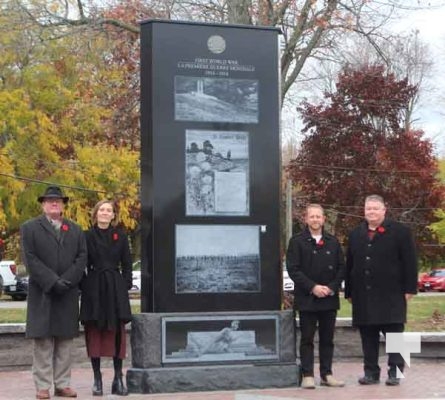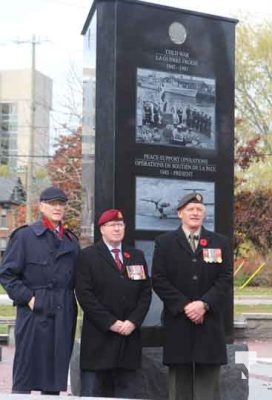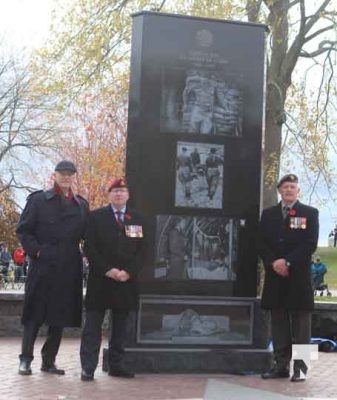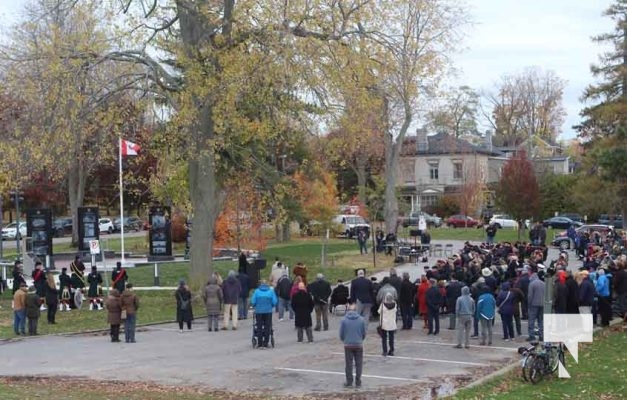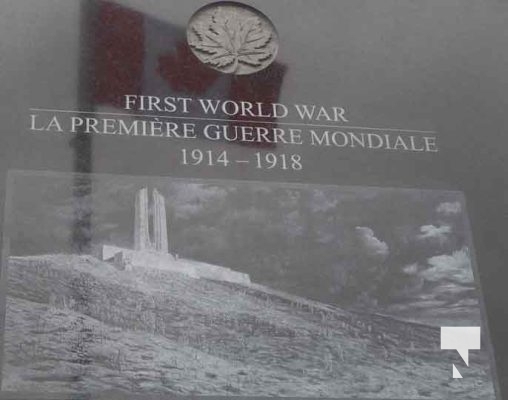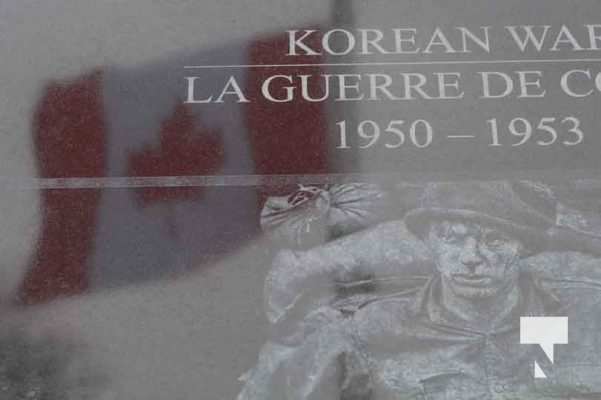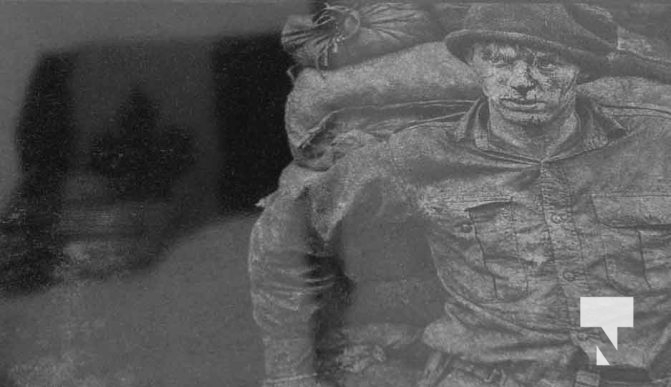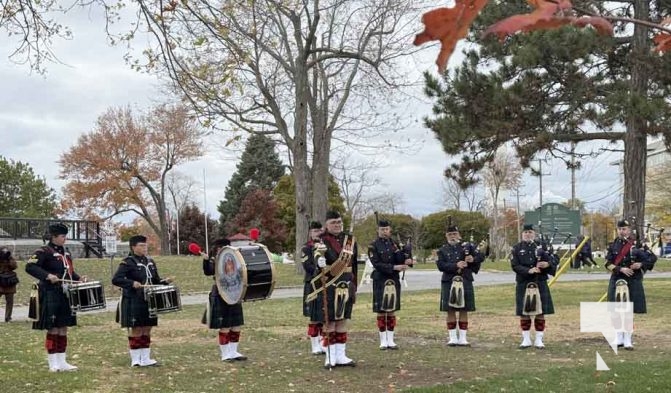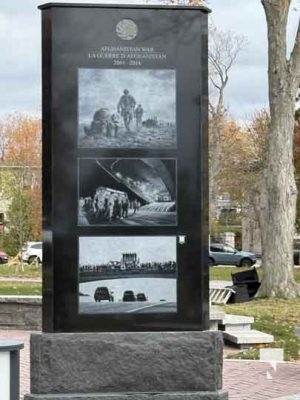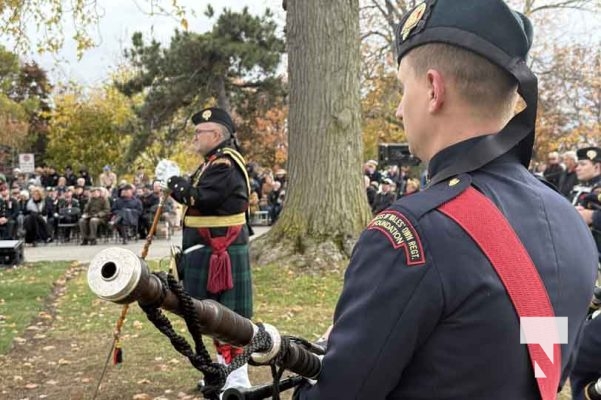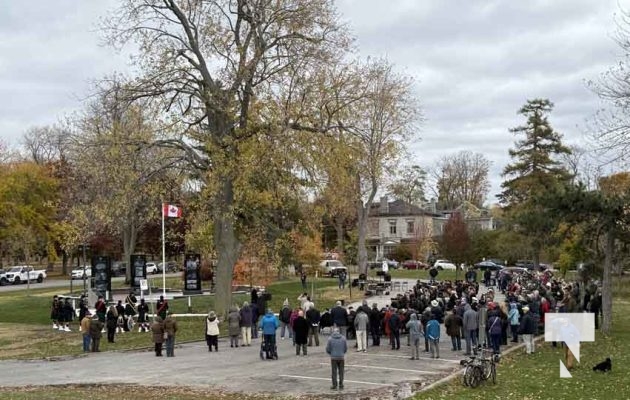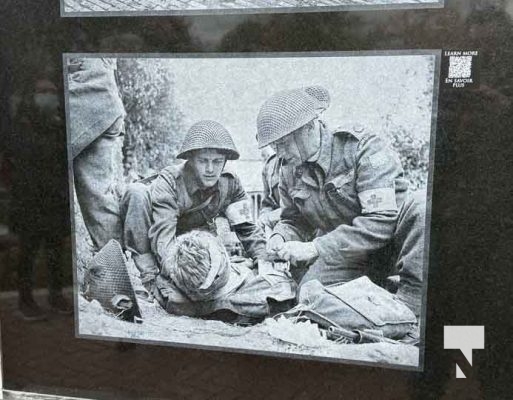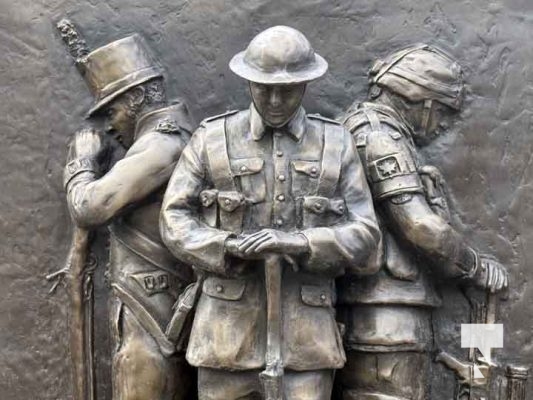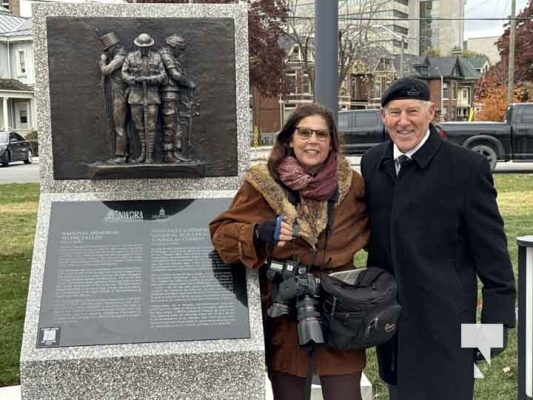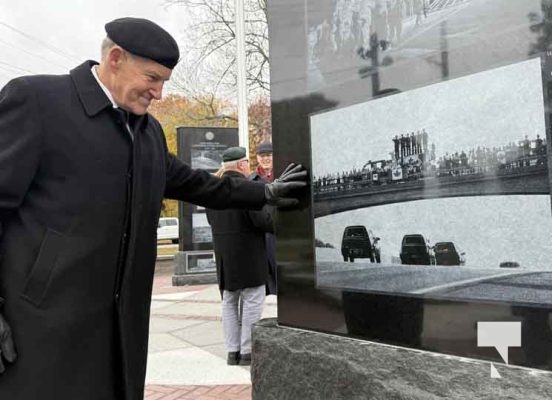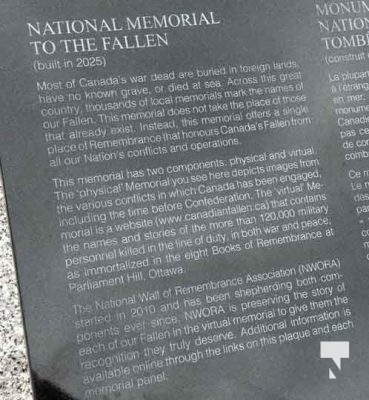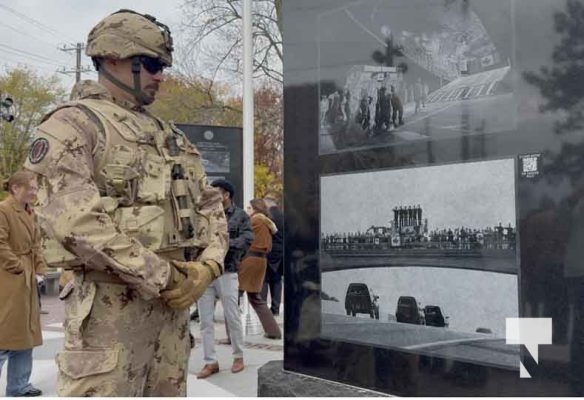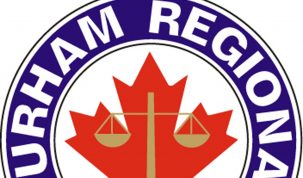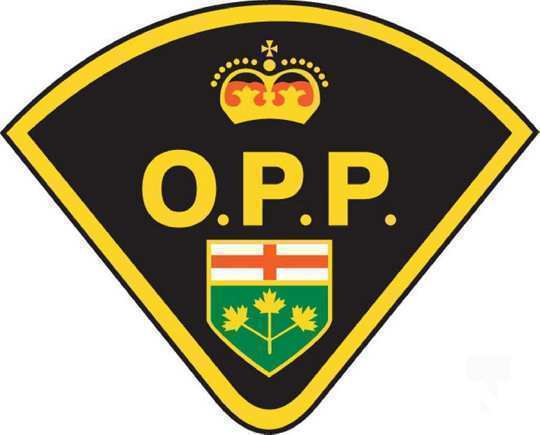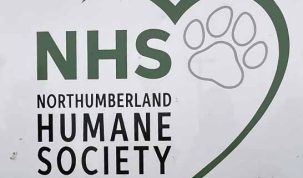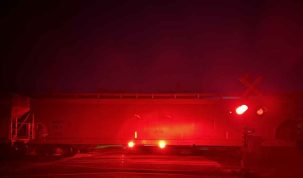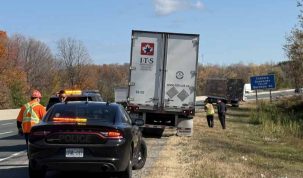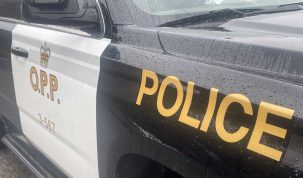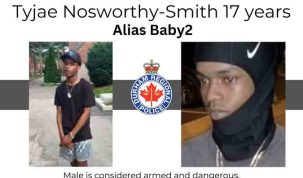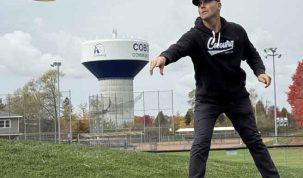A monument honouring fallen soldiers throughout Canada’s history was unveiled in Kingston on Saturday, November 1, 2025.
The memorial kiosk and four pillars are located at Macdonald Park along the shoreline in Kingston.
There ceremony took place at 1 p.m. with a number of special guests and attendees.
The memorial kiosk states that most of Canada’s war dead are buried in foreign lands, have no known grave, or died at sea. Across Canada, thousands of local memorials mark the names of our Fallen. This memoirla does not take the place of this that already exist. Instead, this memorial offers a single place of Remembrance that honours Canada’s Fallen from all our Nation’s conflicts and operations.
This memorial has two components” physical and virtual. The “physical” Memorial depicts images from various conflicts in which Canada has been engaged, including the time before Confederation. The “virtual” Memorial is a website (www.canadianfallen.ca) that contains the names and stories of the more than 120,000 military personnel killed in the line of duty, in both war and peace, as immortalized in the eight Books of Remembrance at Parliament Hill in Ottawa.
The National Wall of Remembrance Association (NWORA) started in 2010 and has been shepherding both components ever since. NWORA is preserving the story of each of our Fallen in the virtual memoral to give them the recognition they truly deserve. Additional information is available online through the links on the plaque and each memorial panel.
Lieutenant-Colonel (retd) Louis Cyr – CID, CD was the emcee for the unveiling. Below are his notes:
Kiosk
Good Afternoon Ladies, Gentlemen and honoured guests It’ s truly a privilege for me to be with you here today,, to formally unveil this memorial. If I could draw your attention to what we refer to as The Welcoming Kiosk. Here at this entrance point, visitors will have an opportunity to see a short description of the memorial and the story behind it. For your convenience the text etched on the kiosk is also printed in the pamphlets you received today.
The bronze relief at the kiosk was created by local artist Sylvia Pecota whose collaboration and artwork here and on each of the pillars has been exceptional and greatly appreciated by everyone involved. The detailed and historically accurate bronze relief depicts soldiers from three eras in the traditional “ Rest On Arms Reversed” position
PILLARS GENERAL INTRODUCTION
As you will see, the pillars each commemorate an era or event in our history as a Nation. More specifically, the pillars themselves and the individual images engraved on the granite surfaces, have been designed and selected to honour and recognise the commitment and sacrifices made by our fellow Canadians – past and present.
At the base of each pillar, is a stylized figure, accompanied by a single word. The words are: Service , Sacrifice, Honour and Mourning. But these are more than just words. Together, they form the theme and foundation of this memorial.
We often view conflicts, as important turning points, in our collective past, but for our purposes here, history is the context, not the focus. This memorial is about the people of our great nation, not the events. People who served with dedication and honour, often suffering great hardship – and for many, making the ultimate sacrifice. These heroes of our past were often ordinary folks, from all walks of life.
Yet they stepped forward when called, and served with commitment and honour, despite the cost.
The images etched into these stone pillars are intended to remind us of those, who lived the events of our history, from long before Confederation up to and including those who serve today.
For Canada – the fabric of our past is made up of an inseparable relationship between First Nations, French, English and many others. As with any nation there have always been competing visions, conflicts and alliances. This memorial though is about honourable people, not their causes. It is their devotion to duty and the sacrifices they made, that bring us here today.
You will see, at the top of each pillar, a small maple Leaf. This symbol of Canada, is modeled after a similar leaf which adorns the crosses and grave markers, for thousands of Canadian soldiers buried in foreign lands. Placed at the top of each pillar, this emblem, links the pillars together, under one principle that is: “ In The Service of Canada.”
Each pillar also bears an imbedded QR code, which when accessed, takes you to our our website, where visitors can learn more about the individual images. This site also provides additional links to other resources such as Archives Canada and the Canadian War Museum.
Pillar One
Our first pillar – highlights events preceding the First World War. Beginning with a painting, selected to commemorate a comprehensive treaty signed in 1701 at Montreal.
The treaty, often referred to as “The Great Peace of Montreal” ended decades of conflict between First Nations and European allies. But as important as the treaty; is the influence and actions of Huron Chief, Kondiaronk. Acknowledged as a world class statesmen and orator by the French:, Kondiaronk eloquently advocated for the treaty, convincing his followers and enemies to support the agreement and end decades of war. He died the following day, succumbing to fever, with the treaty in place, as a testament to his courage and force of will.
Though First Nations history long precedes this important event, this painting was chosen as a starting point, bridging the shared history of Europeans and First Nations, to be honoured equally in the theme of this memorial.
From here, the panels on this pillar advance through Canadian history, marking key events such as The Plains of Abraham, the American siege of Quebec, The War of 1812 and later the North West Campaign. Worth special mention, is the painting on the centre panel showing “The Battle of Kingston Harbour.”
This notable event, took place in the waters directly behind us, anchoring this location quite firmly to our history.
The few pictures here, cannot begin to properly recount centuries of our history, but perhaps they will remind us to solemnly recognize the many people, from all walks of life, whose sacrifices helped forge our nation. Farmers and Merchants who formed the militia, First Nation leaders, and warriors, soldiers and sailors, both French and English. Some of these figures, are giants of our past – Tecumseh , Brock, Wolfe and Montcalm but there are thousands of others, less well known, who should not be forgotten.
Pillar Two
The second pillar is devoted entirely to the events of the First World War. As a young nation, Canada called upon men and women from across the country to pick up the torch and serve. More than 650,000 Canadians answered the call. Roughly one tenth of our population at that time. Ypres, Somme, Passchendale and of course Vimy Ridge, became familiar names and benchmarks to nationhood and international recognition. The pictures selected for this pillar serve to remind us of the human costs, almost unimaginable today. 66,000 Canadians never returned home and a further 172,000 lived with wounds for the rest or their lives. Their stories are remarkable: The people of Newfoundland, although not a members of Confederation at the time, suffered hugely disproportionate losses in the Somme offensive, losing over 700 young men in the first minutes of the battle. A tremendous blow for the small close knit communities they left behind, but one shared, in varying degrees, by almost every, city, village, town and family in the nation.
And this war was different: For the first time – Canadian Nurses, known as “Bluebirds”, shared the hardships of conflict and suffered combat casualties on the front lines, while others were lost at sea, as depicted in the poster shown on the side panel.
The courage and commitment of these Canadians has not faded over time, and it is our responsibility to ensure it never does. This pillar is a bookmark, reminding us to look deeper into our history, and the stories of the fallen, to keep their memories alive and better understand, and appreciate, the sacrifices they made on behalf of our country.
Pillar Three
The pictures etched on these stones, speak to another generation of Canadians who endured the hardships and dangers of the Second World War. More than one million, soldiers sailors, air crew, nurses and merchant mariners, saw active duty between 1939 and 1945. From Hong Kong to Dieppe – Sicily to Antwerp and of course, Juno Beach: Canadians answered the call.
For those who served – the war was long and arduous. These few images remind us of those lost at sea, and in the skies over Europe. The harsh conditions endured by prisoners of war in South East Asia and the intensity of stepping off a landing craft in Normandy. These panels, also honour the chaplains, nurses and medics who cared for the wounded, under the worst of conditions, risking, and at times losing, their own lives in the process.
On the side panel we see sailors, stranded on the stormy seas in a small life raft, hoping for rescue, that for some never arrived reminding us of the crucial work of the Merchant Navy and the perils of convoy duty in the North Atlantic
Visitors will also see, a famous photograph, popularly known as “Wait For Me Daddy “ showing a young boy running after his father, who is marching away on the streets of New Westminster BC. Images like this can serve to remind us that the families of the men, and women, who served also made sacrifices and too often endured loss.
There were also lesser known incidents closer to home that history might be tempted to overlook – such as the sinking of the Canadian ship, SS Caribou. Torpedoed by a U- Boat in the Cabot straight with the loss of loss of 137 souls, including nurses, wounded soldiers and crew. The front page headlines pictured here, remind us that tragedy and loss was not always limited to distant shores.
This pillar is dedicated to the memory of the 45,000 casualties of the Second World war – fellow Canadians who will always deserve our respect and honour. Separated from us by generations, but forever a part of our community.
Pillar Four
Our last panels recall the conflict in Korea, The Cold War, Peace Keeping, and Afghanistan. While the hardship and losses of the First and Second World Wars cannot be overstated, these events, from 1945 to the present, were no less traumatic for those involved. 26,000 Canadians supported the United Nations Command in Korea, over the course of three years. The Korean War Book of Remembrance, in Ottawa, records 516 names of those Canadians who never made it home home. Many more were wounded, and others suffered, less visible, but no less severe traumas. One need only look at the face of Private Heath Mathews, pictured on the centre panel, to understand – even fleetingly – the effects of what he endured.
An image like this may help us see Mathews and his companions, at a more personal level, young people who volunteered to serve their country, a son or brother, not simply a little known soldier from a long ago war. The same holds true for, 130 Canadians taken from us while on active duty with Peace Keeping missions around the world: Including nine air crew, shot down over Syria, and remembered on this panel with an image of a Buffalo aircraft, similar to the one they were flying on the day of the tragedy. They – all of them – are more than just names from the past.
This final pillar also commemorates the hundreds of Canadians who lost their lives during the Cold War. That these losses were often accidental, occurring on routine patrols, training flights or accidents at sea: in no way diminishes the sorrow of their families or the valour of their individual commitment to our nation.
The remaining panel, memorializes our soldiers, engaged in the more recent conflict in Afghanistan. The painting titled “ Fallen” at the top, was selected by the Veterans who unveiled this pillar for you today, each one of them saw active duty in Afghanistan and for them, the scene captured the memory, and emotion of the moment.
The last two photographs engraved on these panels are very well known to Canadians. Most of us will recall seeing the somber “Ramp Ceremonies”, marking a soldiers final journey home.
And: what more could be said about our last image than this. It’s called“ The Highway of Heroes” for good reason. Canadians, pictured here, gathered together, quite spontaneously, to pay their respects and bid farewell.
This picture and the story behind it, should serve to remind us how, and why, we stood together at that moment. Pausing to acknowledge and respect someone we probably never knew, who gave everything on our behalf.
With your permission I would take this opportunity to thank Mr. Peter Fisher, the photographer who took that picture and is here with us today.
With that Ladies and Gentlemen and Honored guests I thank you for your patience and attention and I hope these paintings, photographs and sculptures will always serve to remind us of the people who lived our history and the sacrifices they made.


